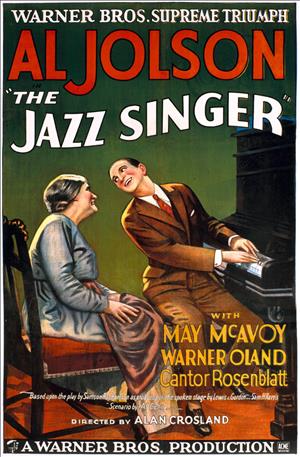On December 30, 1927, The Jazz Singer, the first commercially successful full-length feature film with sound, debuts at the Blue Mouse Theater at 1421 5th Avenue in Seattle. The movie uses Warner Brothers' Vitaphone sound-on-disc technology to reproduce the musical score and sporadic episodes of synchronized speech.
This was the first showing of the film on the West Coast after it opened in New York City in October. Costing its studio, Warner Bros., the (then) enormous sum of $500,000 to make, the picture starred Al Jolson (1886-1950). Tickets at the Blue Mouse were 50 cents each, double the pre-talkie price, but far less than what audiences were paying for tickets on the Great White Way (i.e. Broadway in New York with its blazing marquees).
The Jazz Singer, based the stage play by Samson Raphaelson (itself based on Alfred Cohn’s story "The Day of Atonement"), cast Jolson as a cantor’s son who pursues a career as a vaudeville song and dance man, spurning the wishes of his Jewish parents, who would rather he sung traditional music. The picture, a highly sentimental one, was surprisingly effective and “moved crowds to tears yesterday at the Blue Mouse” (“Al Jolso[n] in Jazz Singer Stirs Crowds”).
Although the song and dialogue portions of The Jazz Singer were limited to a handful of scenes, they meshed nicely with the rest of the film, shot in silent film format. Interestingly, the Vitaphone movie -- together with several Vitaphone shorts -- competed on the same bill with the Movietone News, shot using a competing sound-on-film technology. Sound-on-film would eventually become the industry standard.
There was actually a minor Seattle connection with the specific movie that is credited with debuting a fully synchronized orchestral soundtrack. In August 1926 the Hollywood film Don Juan (with John Barrymore) was released with a musical score performed by the New York Philharmonic as conducted by Henry Hadley (1871-1937). And it was Hadley whose 1909-1911 stint as director with the Seattle Symphony Orchestra saw record-breaking attendance and much praise heaped upon him by fans as well as the media. Ultimately though, Don Juan failed to recoup its production costs, a disappointed Warner Brothers shifted focus to promoting The Jazz Singer, and its overwhelming success caused the former movie's historical status to fade and the latter to often be misidentified as the world's first "soundie."

